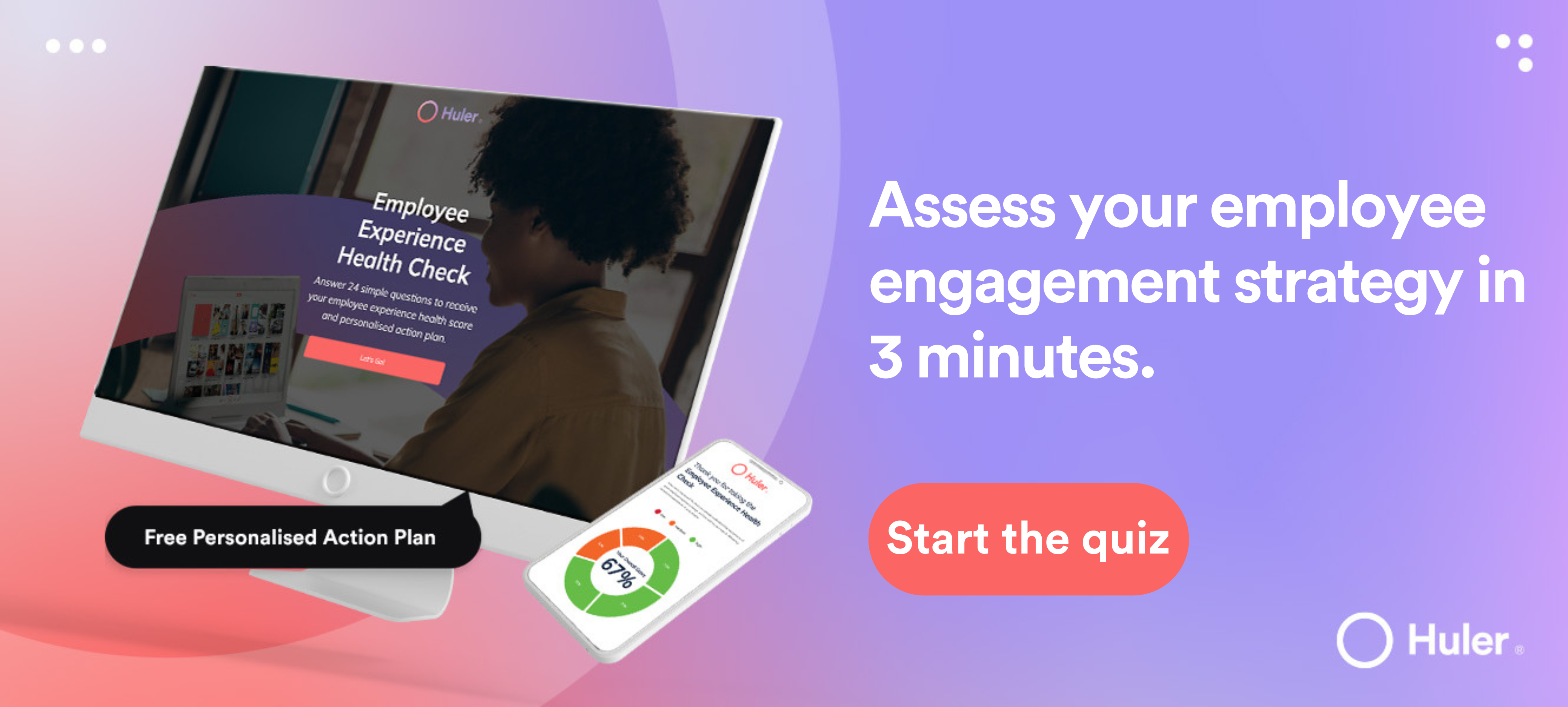As remote and hybrid working become the norm, a good internal communication software for business is indispensable. Employees need to stay up-to-date with company information, but also feel a sense of camaraderie with their colleagues. The numbers don’t lie. A recent workplace communication survey found that American businesses lose, on average, $1.2 trillion every year because of poor communications. That’s a staggering $12,506 per employee per year. While in the UK, a mere 8% of employees feel engaged at work.
It’s no surprise, then, that many businesses are creating a Chief Remote Officer role to make sure remote and hybrid workers stay connected. Because if employees aren’t connected, they aren’t engaged. And unengaged employees are unproductive employees, while highly engaged teams see a 17% increase in productivity. In short, internal communication and engagement go hand-in-hand.
In this article, we’ll delve into why effective internal communication is the lifeblood of your business and vital to employee engagement.
Suggested Reading: For tips on how to improve internal communication within your company, read our blog — How to Improve Internal Communication Within Your Business
What is internal communication?
Internal communication refers to the processes and tools used to communicate within an organisation. But good internal communication is about keeping employees connected, informed and engaged with their work. It means:
- developing a shared knowledge of the company’s goals, values, and ways of working
- keeping staff informed about a company’s current activities, providing a voice of authority and trust
- ensuring there is a clear and transparent flow of information across the entire company.
Why is it important?
Internal communication and engagement go hand-in-hand. This means businesses need to prioritise good internal communication to boost employee engagement — and your business’s bottom line. Effective internal communication should:
- be able to reach everybody consistently across all time zones
- be audience-specific, with language and information tailored to employees
- be accessible across all devices, from mobiles to desktops
- share the right information and the right time
- be easy to access, use and understand
- be the bridge between the physical and the digital workplace.
Let’s take a closer look at why internal comms are so important to improving employee engagement.
Consistency between the physical and digital workspace
Businesses don’t work the same way as they did 15, 10 or even 5 years ago. Today, employees are spread across different offices, countries and time zones. This is one of the reasons why good internal communication across your entire workplace is so important. It’s easier in the traditional office to simply pop into a colleague’s office or cubicle to share an update or give an instruction face to face.
It becomes especially challenging when the employees in the office are up to speed with all internal communications simply because they’re there in person, but the remote and hybrid employees aren’t.
But this doesn’t just hit how they work, it can also hit how they feel about their work. If hybrid and remote employees feel isolated from their colleagues or don’t get information as easily as those in the office, their employee experiences take a hit — which has a knock-on effect on their engagement.
That’s why it’s vital to keep internal communication consistent across both physical and digital workplaces.
Getting the message across
As the number of internal communications channels increase through technology, it isn’t always simple to get your message across clearly and consistently. But if you can create consistency between all your employees’ workspaces, not only are they more engaged, but employees who feel that they’re included in internal communication are almost five times more likely to be more productive.
Intranets alternatives, like employee experience platforms (EXPs), can make internal communication easier and more consistent by offering:
- Access anywhere, on any device: Whether you’re working on a laptop, tablet or mobile, people need to be able to stay up to date on whatever platform, wherever they are.
- Consistency: Whether you’re hybrid, remote or in the office everyday, EXPs enable consistency of communication as everyone receives information in the same way, through the same platform, at the same time. Consistency allows businesses to communicate their values to all employees, wherever they are.
- All your tools under one roof: EXPs can house the right combination of employee engagement tools for your business, so everything is under one roof. Making it easy for everyone to communicate and collaborate.
Communicate your company culture
Companies are increasingly understanding that creating a positive corporate culture through internal communication isn’t a nice-to-have — it also makes business sense.
It’s all good and well to make sure PR efforts and external campaigns position your company as people-first to the outside world. But if this isn’t reflected in employees’ daily work, this image will quickly fall apart.
One study, ‘Engage for Success’, which examined companies with the highest level of employee engagement found four main pillars for engagement. One of these was having a ‘strategic narrative’: a company-wide story of the organisation’s culture and goals. But it’s not enough simply to have a goal and story — it has to be properly communicated.
An employee experience platform that takes a people-first approach, like HulerHub, can help you express your company’s culture through all your communication channels.
- Personalised dashboards: By allowing admin customisation, admins can pin notifications, tools and messages to employee dashboards, highlighting what’s important to the company culture.
- Employee recognition: Integrated employee recognition features that are easy to use are examples of a clear culture of recognising and rewarding employees, proudly and publicly.
- Consistent branding: Your company culture is expressed through its visual style too. Ensuring there’s consistency between all workplaces can help create a sense of togetherness.
Setting an example
Culture comes from the top down. If communication is clear from management, this cascades throughout the rest of the business, making sure that everyone’s on the same page and working towards meeting the company’s goals and objectives.
Another two of Engage for Success’s four pillars are:
- Integrity: Leaders acting in alignment with the company’s culture and values.
- Communicative managers: Managers who understand how to communicate well and understand their responsibility to their employees.
When leadership aligns with the company’s culture and employees can see that the organisation is living its values, it results in increased trust and a sense of integrity. Managers who understand how to communicate well and know their responsibility make employees feel:
- Supported in their role: Communicative managers empower their teams and show a commitment to developing and rewarding the capabilities of those they manage are at the heart of company culture.
- Connected and more productive: There’s no business success unless there’s also great internal communication. Productivity can increase by 20 to 25% in companies where employees feel connected.
- Engaged in their work: Great managers ensure that employees all feel part of the team and understand how their work fits into the bigger picture.
HulerHub streamlines internal communication and helps boost employee engagement by bridging the gap between leadership, managers and employees. Through notifications, admins can send updates to the wider company or specific teams, communicating clearly and directly with employees. And by recognising employees publicly, managers can encourage peers to recognise each other.
And by being able to create and share personalised and powerful articles across your digital workspace, you can keep making content that expresses your company’s culture. Yes, you can produce articles to share memos, updates on projects and breaking news — but you can also use it to let people know about people-first updates such as wellbeing initiatives, helping keep employees engaged with their work and workplace.
Communication is a two-way street
When it comes to good internal communication, it takes two to tango. As much as employees want to (and need to!) get the information they need to fulfil their tasks, they also want to be heard.
92% of highly engaged workers say they feel heard in their workplace, compared to 30% of highly disengaged employees. If employees feel spoken at, rather than spoken with in a conversation, their engagement suffers.
Employees want to communicate in two main ways. First, with their colleagues in collaboration to complete their work. And second, to share their thoughts, opinions and concerns. It’s no surprise, then, that Engage for Success’ final pillar is ‘employee voice’: making sure everyone can share their thoughts and are listened to.
Technology is a key enabler of an effective communications strategy, especially with distributed teams. Ensuring communication becomes a conversation means providing ample opportunities for feedback, ensuring line managers are open to and have regular conversations with their team, and ensuring there is transparency and visibility across the organisation.
When employees feel heard, they are more engaged. And when they’re more engaged:
- profitability can increase by as much as 23%
- They’re 4.6 times more likely to do their best work
- absenteeism can decrease by as much as 81%.
EXPs like HulerHub help streamline this communication by hosting all the communication tools teams need within one centralised hub.
Onboarding
Employees are often nervous on their first day. It’s understandable; they want to make a good first impression. But onboarding is as much about the employee’s first impression of the business as it’s about the company’s impression of the employee.
Good internal communication is crucial to make a good first impression and set up employee engagement, from receiving an offer to their first day. This means providing the technology, processes and resources to ensure good communication, regardless of where the employee is located. It’s important at this stage to:
- introduce new employees to the organisation and give them a sense of what company life will be like.
- welcome new employees and help them make a positive first impression.
- reduce information overload by providing new employees with the information and systems they need, when it’s most relevant
- help new remote and hybrid employees feel connected to their team and their colleagues.
Feeling connected from day one through effective internal communication is important when you consider that 91% of employees want to feel connected to their work colleagues and around 85% want to feel more connected to their remote colleagues.
HulerHub’s collections feature can compile information into preboarding and onboarding starter packs that can be easily sent to new employees, helping them engage with your business at their own pace. And as a hub for all communication tools, new starters will have a range of ways to communicate with and feel connected to their new colleagues.
Building an internal communications strategy
Internal communications and a strong company culture are important elements of a winning workplace. But internal communication alone doesn’t guarantee employee engagement — it lays the groundwork for it.
By establishing clear communication for all employees, wherever they are, it helps all aspects of work: the productive, knuckling-down side and the more social aspect of colleague camaraderie.
Technology can boost internal communication, but the right technology can boost internal communication and employee engagement. With HulerHub, you can unite your tools and your teams, and engage your employees through good communication. Book a demo today!







